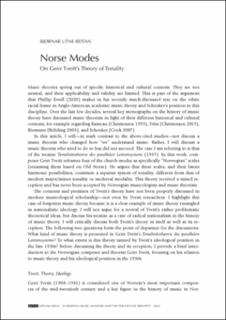| dc.contributor.author | Utne-Reitan, Bjørnar | |
| dc.date.accessioned | 2022-05-30T12:42:01Z | |
| dc.date.available | 2022-05-30T12:42:01Z | |
| dc.date.issued | 2022 | |
| dc.identifier.citation | I: European Music Analysis and the Politics of Identity (DMO Special Issue 2022), s. 46-69 | en_US |
| dc.identifier.issn | 1904-237X | |
| dc.identifier.uri | https://hdl.handle.net/11250/2996868 | |
| dc.description.abstract | Abstract: -
In his treatise Tonalitätstheorie des parallelen Leittonsystems (1937), Norwegian composer Geirr Tveitt attempts to construct a theory of tonality based on Norwegian folk music as an alternative to the established “Inter-European” theories. He reframes four of the church modes as a specifically “Norwegian” or “Norse” tone system (even giving the scales new names based on Old Norse: rir, sum, fum, and tyr). The treatise received a mixed reception and has never been acknowledged by Norwegian music scholars. This article discusses Tveitt’s work discussed as a case of music theory entangled in radical nationalist ideology. | en_US |
| dc.language.iso | eng | en_US |
| dc.publisher | Dansk Musikforskning Online | en_US |
| dc.subject | tonalitet | en_US |
| dc.subject | tonality | en_US |
| dc.subject | Geirr Tveitt | en_US |
| dc.title | Norse Modes : On Geirr Tveitt’s Theory of Tonality | en_US |
| dc.type | Peer reviewed | en_US |
| dc.type | Journal article | en_US |
| dc.description.version | publishedVersion | en_US |
| dc.rights.holder | © forfatterne og DMO | en_US |
| dc.subject.nsi | VDP::Humaniora: 000::Musikkvitenskap: 110::Musikkteori: 112 | en_US |
| dc.source.pagenumber | S. 46-69 | en_US |
| dc.source.volume | Special issue 2022 | en_US |
| dc.source.journal | DMO (Danish musicology online) | en_US |
